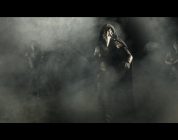From the moment Darling begins– with its gorgeous black and white cinematography romantically and eerily capturing the beauty of New York architecture– the film captivates, enthralls, and takes you on a baroque and strange journey into a descent through madness with style, flair, and unmitigated tour-de-force. The film feels like a long lost film from the 1960s that has only just been discovered. Darling is a psychological thriller in the vain of the European masters of the post-World War II era, like Fellini, Bergman, and more specifically Roman Polanski and his film Repulsion
Darling (Lauren Ashley Carter) has been hired as the newest caretaker at an illustrious New York home that has had its fair-share of hapless past caretakers. The opulent mansion is not without its history and past hauntings, something that Darling has been warned about by Madame, played by Sean Young from Blade Runner fame. It doesn’t take too long for the strange to manifest in the mind of Darling, but whether the ruckus and voices are all in her head or emanating from the home is dubious; ticking clocks, tortured voices, and eerie drones pervade the film’s soundtrack. Darling finds a room at the end of the hall that remains locked and when she inquires about the door, Madame warns that she must never go in there– could this be the source of all of the strangeness of the place and its troubled past? And what’s up with all those hallucinations intercut within moments of seeming normality? They’re part hallucination while others seem more like harbingers and premonitions.
The film’s aural nightmare is what defines and makes Darling so cerebrally palpable. The sound of a seemingly timeless ticking clock counts down to some impending and inevitable doom that no-doubt will befall the protagonist. The film stylistically combines its disquieting cacophony (sound editing and mixing by Shawn Duffy and M. Parker Kozak, respectively) with an eclectic score by Giona Ostinelli. It relies heavily on its sound to not only set its atmospheric tone and mood, but also encapsulates the maddening of Darling’s character. The aural experience is a clash between reality and fantasy and it does it so effectively that one begins to questions the validity of Darling’s experience. Part of the intrigue of the film is not-knowing what is really causing Darling’s strange and absent behavior, leaving gaps for the imagination to fill in.
Writer and director Mickey Keating has made his mark with this film and his masterful direction is accompanied by cinematographer Mac Fisken’s gorgeous chiaroscuro photography that recalls the finest of the European films of the 50s and 60s. The camera eerily lingers as an unseeable and all-powerful force stalks Darling. There is an incredibly beautiful symmetry in the film, from impressively composed wide-shots to barren and simple close-ups that juxtapose the film’s unhinged qualities to deceivingly calm images.
Apart from the film’s technical superiority the star of the show, Lauren Ashley Carter, proves to be more than adequate in portraying madness, with her raw and impressive performance. Carter has no problem with the film’s lack of dialogue which allows for her to exude a range of emotive facial expressions as her mental faculties deteriorate. She plays the role like a subdued silent film star, underpinning the tendency to exaggerate madness with great balance and reserve.
Darling is an exquisite film and cinematic experience that reminds the world that auteurs exist out there and that horror can be just as engaging and fascinating as any genre. This film leaves you wanting more, but offers an undeniable satisfaction, that very few films can match. Darling is a complex and energetically directed masterpiece that is visually stimulating as it is psychologically probing; this one is destined to become a cult-classic.
Darling releases in limited theaters April 1.

